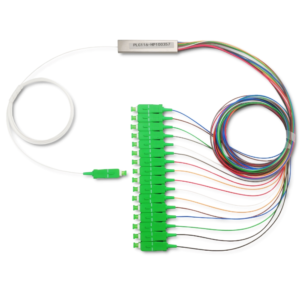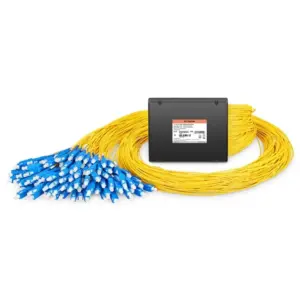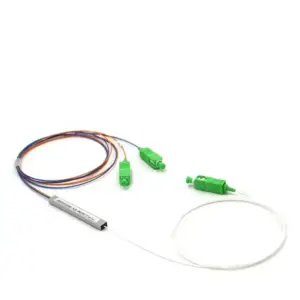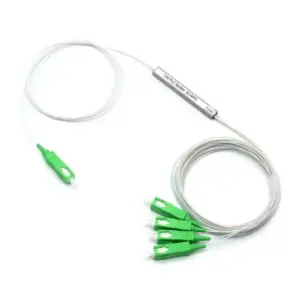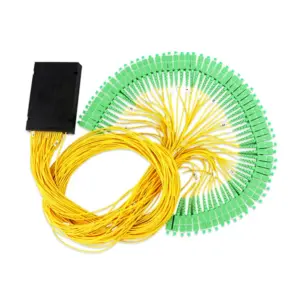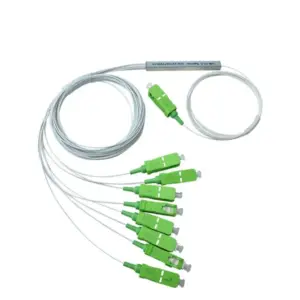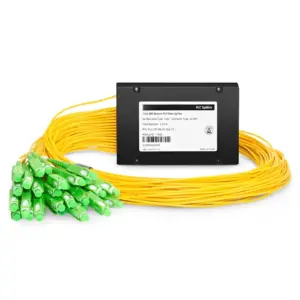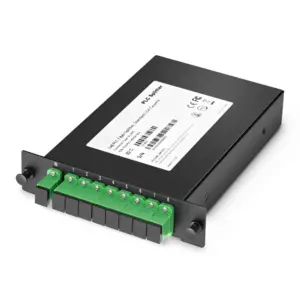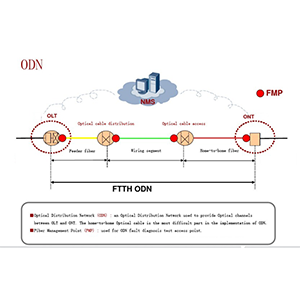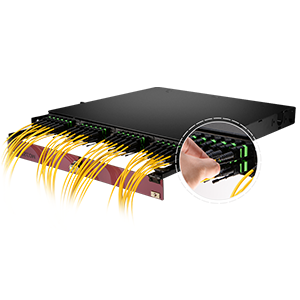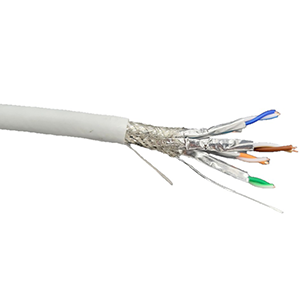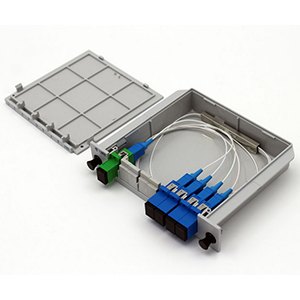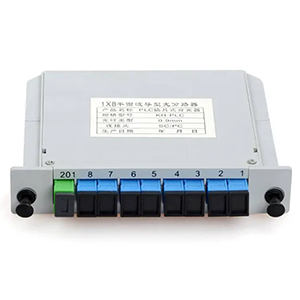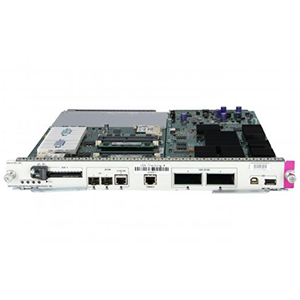In this article, I will take you to deeply explore the mysteries of fiber optic plc splitter, reveal its basic concepts and working principles, and analyze its technical advantages and characteristics. Whether in distributed optical fiber sensing systems in optical fiber networks or in dense wavelength division multiplexing applications in optical fiber communication systems, optical fiber PLC splitters have demonstrated excellent performance and reliability.
1. Basic concepts and working principles of fiber optic plc splitter
The optical fiber PLC splitter is one of the key components in the optical communication system and is used to distribute, combine and process optical signals in the optical fiber network. Its basic concepts and working principles are as follows:
-
Basic Principles:
The optical fiber PLC splitter is based on optical waveguide technology and uses the principles of total reflection and interference of light to distribute and combine optical signals on the optical waveguide chip. Through precisely designed waveguide structures, optical signals can be distributed to different output channels according to predetermined ratios, or multiple input signals can be combined into a single output signal.
How it works:
- Incident optical signal distribution: When the optical signal enters the PLC optical splitter, it is guided to different waveguide channels according to the design on the chip.
- Light transmission and reflection: Optical signals are transmitted in the waveguide structure. Using the total internal reflection characteristics of the waveguide, the signal is guided to different output ports.
- Optical signal combining: If there are multiple input signals, they can enter the PLC optical splitter through different channels and be combined into an output signal inside the chip.
Role and importance in optical communications:
- Signal distribution: Fiber optic PLC optical splitter allows optical signals to be distributed from one input port to multiple output ports, thereby achieving signal distribution and expansion.
- Signal merging: It can also combine multiple input signals into one output signal, which is used to aggregate optical signals from different sources.
- System flexibility: The design of the PLC optical splitter is flexible and can be customized according to system requirements, providing different distribution ratios and channel numbers.
- Reduce loss: During the transmission process of optical signals, the loss of PLC optical splitter is low, which helps to maintain the strength and quality of the signal and improve system performance.
Fiber PLC optical splitter plays a vital role in optical communication systems. Its design and performance directly affect the stability, reliability and performance of the system.
2. Technical advantages and characteristics of fiber optic plc splitter
As an important component in the field of optical communications, fiber optic PLC splitters have many technical advantages and characteristics, making them widely used in optical network systems.
Advantages of high splitting ratio and low insertion loss:
- Fiber PLC optical splitter can achieve high splitting ratio, that is, allocate input optical signals to different output channels to meet the needs of complex optical networks.
- It has the characteristics of low insertion loss, which can effectively maintain the intensity and quality of the optical signal and reduce the energy loss of the signal during the light splitting process.
Technical features for long-term stability and reliability:
- The fiber optic PLC splitter adopts stable optical design and manufacturing technology, has good long-term stability, and can continue to work reliably under different environmental conditions.
- With excellent anti-vibration and anti-interference capabilities, it can maintain stable performance in harsh working environments and ensure reliable operation of optical communication systems.
These technical advantages and characteristics of fiber optic PLC splitters make them an indispensable and important component of optical communication systems, providing reliable basic support for the construction and operation of optical networks.
3. Application of fiber optic plc splitter in optical communication systems
Fiber optic PLC splitters have many important applications in optical communication systems, two of the main application areas include:
Distributed optical fiber sensing system in optical fiber network:
- In distributed fiber optic sensing systems, fiber optic PLC splitters are used to distribute input optical signals to multiple sensing units or sensing areas.
- The optical splitter can distribute optical signals to different optical fiber sensing units to achieve monitoring and control of different locations in the sensing network.
- This application can be used to monitor physical quantities such as temperature, pressure, strain, etc., and is widely used in industrial monitoring, safety monitoring and other fields.
Dense wavelength division multiplexing (DWDM) applications in optical fiber communication systems:
- In dense wavelength division multiplexing systems, optical fiber PLC splitters are used to separate or combine optical signals of different wavelengths to achieve simultaneous transmission of multiple signals.
- Optical splitters play a key role in DWDM systems, helping to achieve high-density and high-speed optical signal transmission, effectively improving the transmission capacity and efficiency of optical communication systems.
- Through the optical fiber PLC splitter, optical signals of different wavelengths can be effectively distributed and combined, making the optical communication system more flexible and scalable.
Fiber PLC optical splitters play an important role in these optical communication applications, providing reliable optical distribution and merging solutions for the construction and operation of optical network systems.
4. Manufacturing and development trends of fiber optic plc splitter
The manufacturing and development of optical fiber PLC splitters is faced with evolving manufacturing processes and market demands. Future development will mainly focus on the following two aspects:
Manufacturing process development and technological improvements:
- With the continuous advancement of manufacturing technology, the manufacturing process of fiber optic PLC splitters is also constantly improving.
- The introduction of new processing technologies, materials and equipment will improve manufacturing efficiency, reduce costs, and enhance the performance and reliability of the spectrometer.
- Manufacturing process improvements also include nanometer-precision machining and surface treatment to ensure optimal optical performance of the spectrometer.
Future development direction: multi-wavelength, high-speed, miniaturization trends:
- Future fiber PLC splitters will tend to support more wavelengths to meet the needs of multi-wavelength applications such as dense wavelength division multiplexing (DWDM).
- With the development of communication technology, the demand for high speed continues to increase, and fiber optic PLC splitters need to support higher speed and data transmission capabilities.
- Miniaturization is another important trend, and fiber optic PLC splitters require smaller and more compact sizes to accommodate the needs of dense integration and high-density layout.
To sum up, the manufacturing and development trends of optical fiber PLC splitters will be driven by the continuous improvement of manufacturing processes and technological innovation. The future development direction will pay more attention to the development of multi-wavelength, high speed and miniaturization. To meet the growing demand for optical communications market.
Summary:
Fiber PLC optical splitter, as the mainstay of optical communication technology, is helping the communication industry move towards a faster and more stable future. Its advantages of high splitting ratio, low insertion loss, as well as long-term stability and reliability make it a leader in the industry. In the future, with the continuous development of manufacturing processes and continuous improvement of technology, fiber PLC optical splitters will usher in the development trend of more miniaturization, multi-wavelength, and high speed.
The integration and application of emerging technologies such as 5G communications and the Internet of Things will further highlight the key role of optical fiber PLC splitters in future communication networks. By choosing our fiber optic plc splitter, you not only get excellent performance and reliability, but also usher in a new revolution in communication technology. Let us work together to create a brilliant future for optical communications!
-
128-channel optical fiber PLC splitter
-
16-channel optical fiber PLC splitter
-
2-way optical fiber PLC splitter
-
32-channel optical fiber PLC splitter
-
4-way optical fiber PLC splitter
-
64-channel optical fiber PLC splitter
-
8-channel optical fiber PLC splitter
-
ABS module PLC fiber optic splitter
-
Box PLC optical fiber splitter

